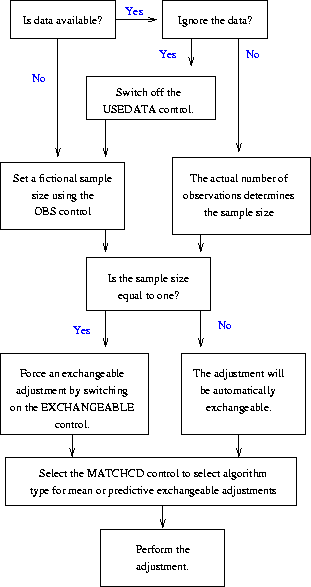




Next: Determining sample sizes to
Up: Organising exchangeable adjustments
Previous: Source of variances and
We show in Figure 16.1 what steps must be considered
in choosing the sample size for a preliminary adjustment. In turn, these are:
- The usedata control. When switched off, actual observations
are ignored, and so a fictitious sample size must be set for the
adjustment. Otherwise the sample size used is the same as the number of
actual observations.
- The obs control. This is used to set a fictitious sample
size, whenever necessary and assuming the absence of (or ignoring)
actual data.
- The exchangeable control. This is used to force the use of
exchangeable beliefs when the sample size, actual or fictitious, is
n=1. (By default, when n=1 [B/D] assumes non-exchangeability for
efficiency.)
- The matchcd control. This is used to force the use of
special algorithms which exploit analytical results to avoid much
unnecessary calculation when the default algorithms are used to
calculate the adjustments. The setting of the control is relevant only
when a predictive or mean component analysis for a pure exchangeable
system is taking place. In these circumstances, the adjustments can be
arranged so that the canonical directions for the mean and predictive
adjustments are the same (except for normalising constants) in the case
of rank degeneracy. (Otherwise, the canonical directions are the same
anyway, except for normalising constants.) However, note that the
setting of this control can, in the case of rank degeneracy, give
canonical directions for the mean component adjustment which are valid
but different (because of non-uniqueness) to the directions computed by
the default algorithm. In particular, if you select the matchcd
control, in the special case of mean component adjustment for an
exchangeable system under rank degeneracy, the canonical directions
reported for the resolution matrix are not generally the same as those
reported when using the default algorithms.
However, we recommend that you set the matchcd control to ON.
These controls are discussed in greater detail in §20.3.
As an example, suppose that you wish to generate a preliminary
adjustment of B by D (assume that these are also the names of the
respective [B/D] bases) where you wish to take initially a sample of size
n=1, and where you wish to ignore the actual observations that you
have on D. Then the following commands are appropriate:
BD>control -usedata ,obs =1,exchangeable 
BD>adjust [B/D] 

Figure 16.1: Controls affecting exchangeable adjustments





Next: Determining sample sizes to
Up: Organising exchangeable adjustments
Previous: Source of variances and
David Wooff
Wed Oct 21 15:14:31 BST 1998
![]()
